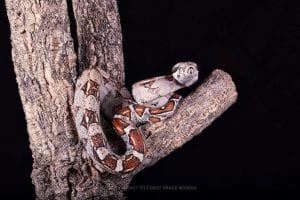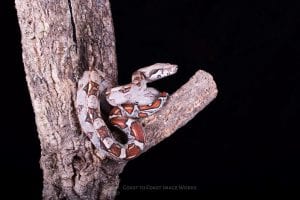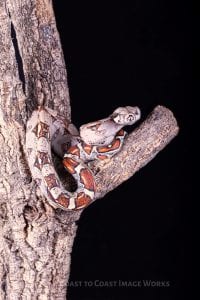 The Common boa name covers a wide range of subspecies within the pet trade, and as most Common boas in the trade are now captive bred, it appears genetic lines are often a mixture of several sub-species. The species on a whole has a wide distribution range through Central and South America in mainly sub-tropical and tropical regions.
The Common boa name covers a wide range of subspecies within the pet trade, and as most Common boas in the trade are now captive bred, it appears genetic lines are often a mixture of several sub-species. The species on a whole has a wide distribution range through Central and South America in mainly sub-tropical and tropical regions.
This species is a large snake, females can grow in excess of three metres. For this reason, the topic of keeping this species should not be taken lightly – at the very least thought should be given to the large housing required. There is a movement within the hobby that views housing a snake that cannot fully stretch its own length is no longer acceptable. If you subscribe to this view point you will require, for a large female, a vivarium at least three metres in length, maybe longer. As they are arboreal, an absolute minimum height for the vivarium would be one metre, preferably two. This size of housing means they are often outside the scope of many households. Don’t forget, they are powerful snakes and the construction of the vivarium needs to be strong and very well made. For the same reason, any handling of a large female should be taken very seriously, and only by two people, if for no other reason than to distribute the weight of the snake.
 Heating can be provided by firmly fixed and well-guarded ceramic heaters, couple this with lighting designed for forest dwellers, such as Arcadia’s ShadeDweller T5 lighting system. Temperatures need to be around 30-32C in the “hot end” of the vivarium during the day-time, dropping to around 25-26C during the night time hours. Altering photoperiod and temperatures seasonal isn’t essential unless breeding attempts are to be made – a photoperiod of twelve hours of day and night will suffice for regular maintenance.
Heating can be provided by firmly fixed and well-guarded ceramic heaters, couple this with lighting designed for forest dwellers, such as Arcadia’s ShadeDweller T5 lighting system. Temperatures need to be around 30-32C in the “hot end” of the vivarium during the day-time, dropping to around 25-26C during the night time hours. Altering photoperiod and temperatures seasonal isn’t essential unless breeding attempts are to be made – a photoperiod of twelve hours of day and night will suffice for regular maintenance.
For many people a “sterile” approach is easier to maintain, this means keeping the vivarium furniture to a minimum to aid keeping things clean. If this approach is preferred the bare minimum would be at least one stout branch for climbing, an easily changed floor covering and a large water bowl for soaking. However, to many keepers such an approach isn’t ideal, and this is where things become even more difficult for a keeper. The more  complexity in the vivarium for a large species makes life more difficult. As for cleaning the vivarium, this needs to be a daily spot clean, taking out any shed skin or faecal matter and then a full deep clean at least every couple of weeks. This species can be very messy.
complexity in the vivarium for a large species makes life more difficult. As for cleaning the vivarium, this needs to be a daily spot clean, taking out any shed skin or faecal matter and then a full deep clean at least every couple of weeks. This species can be very messy.
Feeding presents its own problems, and a supply of large food items should be sourced. For a large female this could be a supply of rabbits or similar. A large adult will not require feeding any more frequently then every 14-28 days, depending on current weight and activity levels.
A stunning looking species, but one that provides certain challenges and full commitment from the keeper.
